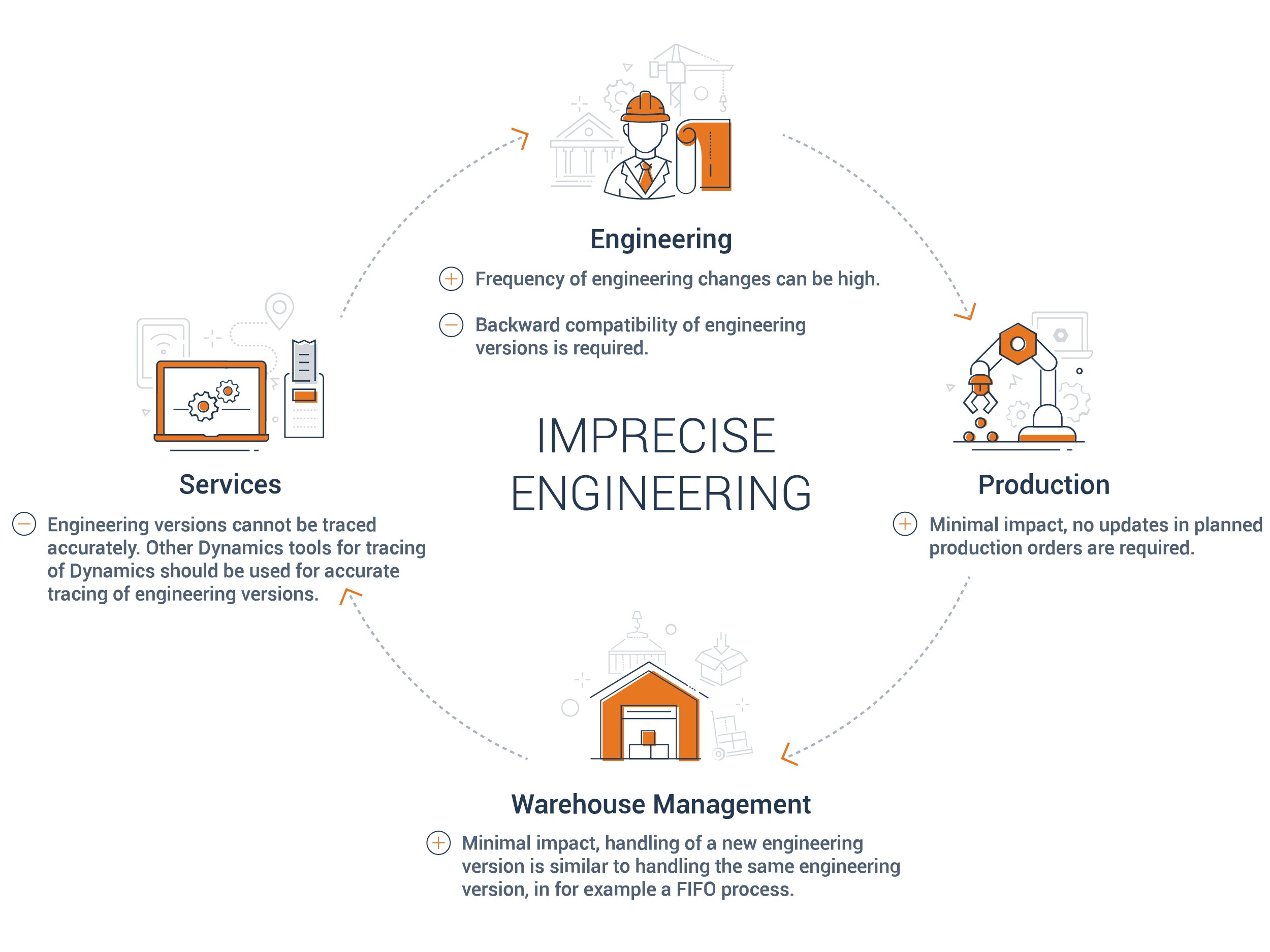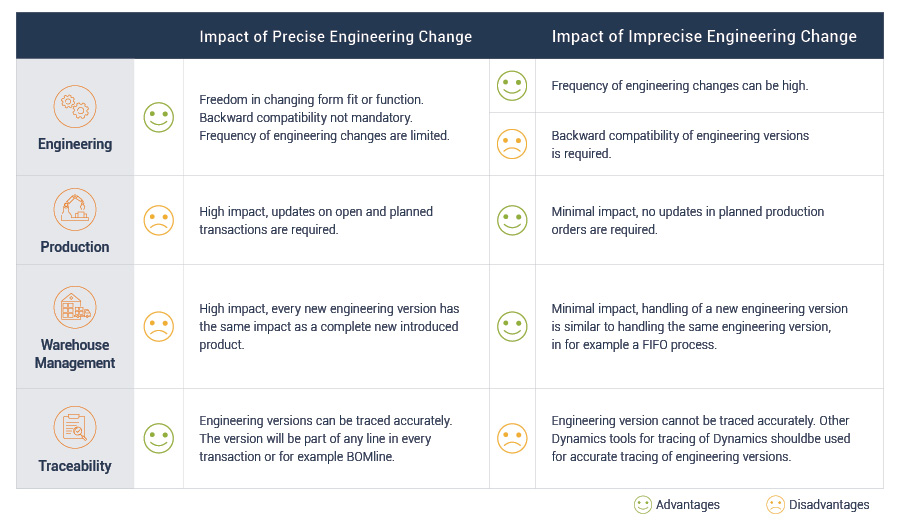While “precision” is difficult to quantify in precise engineering and imprecise engineering implies “uncertainty”, both the engineering methods provide an interesting facet to the engineering design process and are critical for the overall product development at various stages and in version updates. Keeping track of history can impact freedom of a product's development as there would be limited number of changes, concerning the manufacturer as well as the customer who is looking forward to an updated version or is facing problem with the existing version. Let’s decode engineering standards to manage the impact of a new product version in the world of ERP.
What’s the Difference between Precise and Imprecise Engineering?
When a product is at the early stage of development, it is to be decided whether the process would be imprecise or precise. There is no going back when the decision is already made as both precise and imprecise have defined routes in product development. Whether you are going for precise or imprecise, it is imperative to make decision during the implementation of the solution before going live.
This blog will explain the difference between precise and imprecise engineering by using an example going over in all the subprocesses of the main engineering to manufacturing processes.
Case
In this case, we will follow the internal process of a manufacturing company, let’s call it Imperia Manufacturers. The company has 50-200 number of employees. Among them are:
1. Edward, the engineer
2. Rita, the warehouse manager
3. Peter, the production manager
4. Sally, head of services
This manufacturing company is into designing brackets, and so we will follow the upgrade of a bracket with four holes to a bracket with slot holes. Edward designed a bracket which is used to secure and assemble products. The bracket has four holes to mount products during assembly.
At some point, during assembly, the product manager, Peter, has found out that mounting products is not that easy due to the tight tolerance of the holes. He orders his employees to drill the holes manually to a larger diameter, if necessary, to enable the mounting of products. This is a suitable, but costly and unplanned operation. Peter notices that a large order with brackets is planned and decides to ask for an engineering change. Edward and Peter decide that replacing the four holes with slot holes will cover Peter’s engineering change request.
During approval of the engineering change, another engineering change request for reducing the number of holes was discussed and as a result it was found that, from now, three slotholes should be enough to mount the newly delivered products of Imperia.
Example: Precise Engineering
For this bracket the company Imperia uses a precise process for engineering. Edward finishes the design and saves it as a new version of the bracket; Edward has also reduced the number of holes to three as approved during the engineering change. He knows he could do this because all versions are tracked within all transactions of Imperia. If a customer asks for a replacement of the first version of the bracket (the one with the four holes) then Imperia will just deliver the first version again. The company will be sure it will fit the demand.
As soon as the stock of the first version of the bracket with holes is sold out, the second version of the bracket with the slot holes will be produced and kept in stock. Production manager Peter notices that in his newly planned order, this bracket needs to be replaced with the new version of the bracket. He checks the stock, and together with the warehouse manager, Rita, he decides to start using the new version of the bracket when the first version has run out of stock. Rita, on her end, needs to find a new shelf in the warehouse to store the new version of the bracket because any product version managed stock needs its own shelf at Imperia. As soon as the first version of the bracket runs out, she might be able to free up that shelf for future use.
When the stock of the first version runs out, Peter updates all lines in the production orders, and the second version of the bracket is now used in production. Peter is happy to see that the new version of the bracket is easier to install and does not have to be drilled anymore, saving his department time. However, Peter also realizes that the change of a version took him some effort for updating open production orders and Rita had to adjust the warehouse to find a new shelf for the second version of the bracket.
After delivering the second version of the product to several customers, Sally from services receives many compliments about the quality of the second version of the bracket. Also, a customer requests to replace earlier delivered first versions of the bracket with the new bracket with slot holes. Together with Peter, Sally investigates all historical sales orders to accurately find out when and in which quantity the first version of the brackets was delivered to the customer. Sally also finds out that the first version of the bracket was also delivered to five other customers in the historical sales order. All other customers who received this bracket only received the newest version of the bracket. Sally offers the six customers a complete upgrade with the correct number of brackets which were delivered to the customers, resulting in efficiency and on time delivery.
When using a precise engineering process, the impact on required change in planned transactions, inventory and minimum stock requires manual interference per engineering change.
The feasible number of engineering changes of products in planned transactions is limited. But the traceability of products is fully supported when using a precise engineering process.
Example: Imprecise Engineering

In this example, Imperia uses an imprecise process for engineering. Edward finishes the design and saves the design as a new version of the bracket. He did not reduce the number of holes, because he realized that since the version upgrade will be imprecise, the first and the second version need to be backward compatible. If a customer asks for a replacement of an earlier delivered bracket, Imperia will not know which version needs to be delivered. Now, Imperia will just deliver the second version with four slot holes, which can always replace the first version of the bracket.
The stock of the first version of the bracket with holes will be sold out, when reaching a minimum quantity, the second version of the bracket with the slot holes will be automatically planned, produced and kept on stock. Product manager Peter notices that on his production order, the version is not checked. Peter realizes that in his newly planned order lines, this bracket does not need to be replaced with the new version of the bracket.
He checks the stock together with the warehouse manager, Rita. Peter and Rita decide to use the First-In-First-Out principle , and Rita will make sure to use up all the stock of the first version before delivering stock of the second version to Peter. Since the version is not traced for stock as well, Rita uses the same shelf and places the new versions of the bracket on the end of the shelf, facilitating the FIFO principle. Rita and Peter also conclude that if Rita would use the FIFO principle for the majority of their products, Rita does not even need to be informed any more when a new version of a product is phased in, saving Peter and Rita a lot of time per engineering change.
After delivering the second version of the product to several customers, Sally from services receives several compliments about the quality of the second version of the bracket. Also, a customer requests to replace all early delivered first versions of the bracket with the new bracket with slot holes.
Together with Peter, Sally investigates all historical sales orders to try to find out which version was delivered to which customer. However, Sally and Peter find out that also on historical sales orders the version is not tracked. Peter has one last trick up his sleeve, for both versions of the bracket he entered the effectivity (when the versions become effective) dates. Sally and Peter find out that on the first of June, the second version of the bracket was phased in. Now, Sally can make an educated guess to which customers and in which quantities the new version of the bracket was delivered. However, she cannot offer exact amounts of brackets in her offer to the customers.
When using an imprecise engineering process, the traceability of delivered products can only be done using other Dynamics tools for traceability. However, the impact on required change in planned transactions, inventory and minimum stock is minimal, supporting a high frequency of engineering changes.

To-Increase Product Engineering Solution helps you with version management
To make a perfect product, lessons learne at various stages of manufacturing are stepping stones. And, to manage these changes, descriptions and orders, a proper way of tracking is required. At To-Increase we understand your concerns about numerous versions and our solutions support both precise and imprecise engineering.
When it comes to the manufacturing industry, there is an immense need for empowering the business as well as the processes and people with the right methodologies, deep insights, resource optimization, and compliance to handle product changes.
Our To-Increase Product Engineering solutions with trusted PLM integration helps you to become customer-centric and optimize to scale up fast and grow exponentially.






